East Rail line
| East Rail line 東鐵綫 | |||||||||||||||||||||||||||||||||||||||||||||||||||||||||||||||||||||||||||||||||||||||||||||||||||||||||||||||||||||||||||||||||||||||||||||||||||||||||||||||||||||||||||||||||||||||||||||||||||||||||||||||||||||||||||||||||||||||||||||||||||||||||||||||||||||||||||||||||||||||||||||||||||||||||||||||||||||||||||||||||||||||||||||||||||||||||||||||||||||||||||||||||||||||||||||||||||||||||||||||||||||||||||||||||||||||||||||||||||||||||||||||||||||||||||||||||||||||||||||||||||||||||||||||||||||||||||||||||||||||||||||||||||||||||||||||||||||||||||||||||||||||||||||||||||||||||||||||||||||||||||||||||||||||||||||||||||||||||||||||||||||||||||||||||||||||||||||||||||||||||||||||||||||||||||||||||||||||||||||||||||||||||||||||||||||||||||||||||||||||||||||||
|---|---|---|---|---|---|---|---|---|---|---|---|---|---|---|---|---|---|---|---|---|---|---|---|---|---|---|---|---|---|---|---|---|---|---|---|---|---|---|---|---|---|---|---|---|---|---|---|---|---|---|---|---|---|---|---|---|---|---|---|---|---|---|---|---|---|---|---|---|---|---|---|---|---|---|---|---|---|---|---|---|---|---|---|---|---|---|---|---|---|---|---|---|---|---|---|---|---|---|---|---|---|---|---|---|---|---|---|---|---|---|---|---|---|---|---|---|---|---|---|---|---|---|---|---|---|---|---|---|---|---|---|---|---|---|---|---|---|---|---|---|---|---|---|---|---|---|---|---|---|---|---|---|---|---|---|---|---|---|---|---|---|---|---|---|---|---|---|---|---|---|---|---|---|---|---|---|---|---|---|---|---|---|---|---|---|---|---|---|---|---|---|---|---|---|---|---|---|---|---|---|---|---|---|---|---|---|---|---|---|---|---|---|---|---|---|---|---|---|---|---|---|---|---|---|---|---|---|---|---|---|---|---|---|---|---|---|---|---|---|---|---|---|---|---|---|---|---|---|---|---|---|---|---|---|---|---|---|---|---|---|---|---|---|---|---|---|---|---|---|---|---|---|---|---|---|---|---|---|---|---|---|---|---|---|---|---|---|---|---|---|---|---|---|---|---|---|---|---|---|---|---|---|---|---|---|---|---|---|---|---|---|---|---|---|---|---|---|---|---|---|---|---|---|---|---|---|---|---|---|---|---|---|---|---|---|---|---|---|---|---|---|---|---|---|---|---|---|---|---|---|---|---|---|---|---|---|---|---|---|---|---|---|---|---|---|---|---|---|---|---|---|---|---|---|---|---|---|---|---|---|---|---|---|---|---|---|---|---|---|---|---|---|---|---|---|---|---|---|---|---|---|---|---|---|---|---|---|---|---|---|---|---|---|---|---|---|---|---|---|---|---|---|---|---|---|---|---|---|---|---|---|---|---|---|---|---|---|---|---|---|---|---|---|---|---|---|---|---|---|---|---|---|---|---|---|---|---|---|---|---|---|---|---|---|---|---|---|---|---|---|---|---|---|---|---|---|---|---|---|---|---|---|---|---|---|---|---|---|---|---|---|---|---|---|---|---|---|---|---|---|---|---|---|---|---|---|---|---|---|---|---|---|---|---|---|---|---|---|---|---|---|---|---|---|---|---|---|---|---|---|---|---|---|---|---|---|---|---|---|---|---|---|---|---|---|---|---|---|---|---|---|---|---|---|---|---|---|---|---|---|---|---|---|---|---|---|---|---|---|---|---|---|---|---|---|---|---|---|---|---|---|---|---|---|---|---|---|---|---|---|---|---|---|---|---|---|---|---|---|---|---|---|---|---|---|---|---|---|---|---|---|---|---|---|---|---|---|---|---|---|---|---|---|---|---|---|---|---|---|---|---|---|---|---|---|---|---|---|---|---|---|---|---|---|---|---|---|---|---|---|---|---|---|---|---|---|---|---|---|---|---|---|---|---|---|---|---|---|---|---|---|---|---|---|---|---|---|---|---|---|---|---|---|---|---|---|---|---|---|---|---|---|---|---|---|---|---|---|---|---|---|---|---|---|---|---|---|---|---|---|---|---|---|---|---|---|---|---|---|---|---|---|---|---|---|---|---|---|---|---|---|---|---|---|---|---|---|---|---|---|---|---|---|---|---|---|---|---|---|---|---|---|---|---|---|---|---|---|---|---|---|---|---|---|---|---|---|
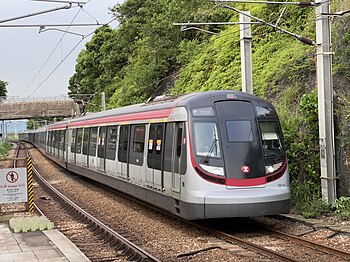 A Hyundai Rotem R-train EMU entering University station
| |||||||||||||||||||||||||||||||||||||||||||||||||||||||||||||||||||||||||||||||||||||||||||||||||||||||||||||||||||||||||||||||||||||||||||||||||||||||||||||||||||||||||||||||||||||||||||||||||||||||||||||||||||||||||||||||||||||||||||||||||||||||||||||||||||||||||||||||||||||||||||||||||||||||||||||||||||||||||||||||||||||||||||||||||||||||||||||||||||||||||||||||||||||||||||||||||||||||||||||||||||||||||||||||||||||||||||||||||||||||||||||||||||||||||||||||||||||||||||||||||||||||||||||||||||||||||||||||||||||||||||||||||||||||||||||||||||||||||||||||||||||||||||||||||||||||||||||||||||||||||||||||||||||||||||||||||||||||||||||||||||||||||||||||||||||||||||||||||||||||||||||||||||||||||||||||||||||||||||||||||||||||||||||||||||||||||||||||||||||||||||||||
| Overview | |||||||||||||||||||||||||||||||||||||||||||||||||||||||||||||||||||||||||||||||||||||||||||||||||||||||||||||||||||||||||||||||||||||||||||||||||||||||||||||||||||||||||||||||||||||||||||||||||||||||||||||||||||||||||||||||||||||||||||||||||||||||||||||||||||||||||||||||||||||||||||||||||||||||||||||||||||||||||||||||||||||||||||||||||||||||||||||||||||||||||||||||||||||||||||||||||||||||||||||||||||||||||||||||||||||||||||||||||||||||||||||||||||||||||||||||||||||||||||||||||||||||||||||||||||||||||||||||||||||||||||||||||||||||||||||||||||||||||||||||||||||||||||||||||||||||||||||||||||||||||||||||||||||||||||||||||||||||||||||||||||||||||||||||||||||||||||||||||||||||||||||||||||||||||||||||||||||||||||||||||||||||||||||||||||||||||||||||||||||||||||||||
| Other name(s) | Kowloon-Canton Railway British Section 九廣鐵路-英段 KCR East Rail 九廣東鐵 |
||||||||||||||||||||||||||||||||||||||||||||||||||||||||||||||||||||||||||||||||||||||||||||||||||||||||||||||||||||||||||||||||||||||||||||||||||||||||||||||||||||||||||||||||||||||||||||||||||||||||||||||||||||||||||||||||||||||||||||||||||||||||||||||||||||||||||||||||||||||||||||||||||||||||||||||||||||||||||||||||||||||||||||||||||||||||||||||||||||||||||||||||||||||||||||||||||||||||||||||||||||||||||||||||||||||||||||||||||||||||||||||||||||||||||||||||||||||||||||||||||||||||||||||||||||||||||||||||||||||||||||||||||||||||||||||||||||||||||||||||||||||||||||||||||||||||||||||||||||||||||||||||||||||||||||||||||||||||||||||||||||||||||||||||||||||||||||||||||||||||||||||||||||||||||||||||||||||||||||||||||||||||||||||||||||||||||||||||||||||||||||||
| Status | Operational | ||||||||||||||||||||||||||||||||||||||||||||||||||||||||||||||||||||||||||||||||||||||||||||||||||||||||||||||||||||||||||||||||||||||||||||||||||||||||||||||||||||||||||||||||||||||||||||||||||||||||||||||||||||||||||||||||||||||||||||||||||||||||||||||||||||||||||||||||||||||||||||||||||||||||||||||||||||||||||||||||||||||||||||||||||||||||||||||||||||||||||||||||||||||||||||||||||||||||||||||||||||||||||||||||||||||||||||||||||||||||||||||||||||||||||||||||||||||||||||||||||||||||||||||||||||||||||||||||||||||||||||||||||||||||||||||||||||||||||||||||||||||||||||||||||||||||||||||||||||||||||||||||||||||||||||||||||||||||||||||||||||||||||||||||||||||||||||||||||||||||||||||||||||||||||||||||||||||||||||||||||||||||||||||||||||||||||||||||||||||||||||||
| Owner | Kowloon-Canton Railway Corporation | ||||||||||||||||||||||||||||||||||||||||||||||||||||||||||||||||||||||||||||||||||||||||||||||||||||||||||||||||||||||||||||||||||||||||||||||||||||||||||||||||||||||||||||||||||||||||||||||||||||||||||||||||||||||||||||||||||||||||||||||||||||||||||||||||||||||||||||||||||||||||||||||||||||||||||||||||||||||||||||||||||||||||||||||||||||||||||||||||||||||||||||||||||||||||||||||||||||||||||||||||||||||||||||||||||||||||||||||||||||||||||||||||||||||||||||||||||||||||||||||||||||||||||||||||||||||||||||||||||||||||||||||||||||||||||||||||||||||||||||||||||||||||||||||||||||||||||||||||||||||||||||||||||||||||||||||||||||||||||||||||||||||||||||||||||||||||||||||||||||||||||||||||||||||||||||||||||||||||||||||||||||||||||||||||||||||||||||||||||||||||||||||
| Locale | Districts: Yuen Long, North, Tai Po, Sha Tin, Kowloon City, Sham Shui Po, Yau Tsim Mong, Wan Chai, Central and Western | ||||||||||||||||||||||||||||||||||||||||||||||||||||||||||||||||||||||||||||||||||||||||||||||||||||||||||||||||||||||||||||||||||||||||||||||||||||||||||||||||||||||||||||||||||||||||||||||||||||||||||||||||||||||||||||||||||||||||||||||||||||||||||||||||||||||||||||||||||||||||||||||||||||||||||||||||||||||||||||||||||||||||||||||||||||||||||||||||||||||||||||||||||||||||||||||||||||||||||||||||||||||||||||||||||||||||||||||||||||||||||||||||||||||||||||||||||||||||||||||||||||||||||||||||||||||||||||||||||||||||||||||||||||||||||||||||||||||||||||||||||||||||||||||||||||||||||||||||||||||||||||||||||||||||||||||||||||||||||||||||||||||||||||||||||||||||||||||||||||||||||||||||||||||||||||||||||||||||||||||||||||||||||||||||||||||||||||||||||||||||||||||
| Termini | |||||||||||||||||||||||||||||||||||||||||||||||||||||||||||||||||||||||||||||||||||||||||||||||||||||||||||||||||||||||||||||||||||||||||||||||||||||||||||||||||||||||||||||||||||||||||||||||||||||||||||||||||||||||||||||||||||||||||||||||||||||||||||||||||||||||||||||||||||||||||||||||||||||||||||||||||||||||||||||||||||||||||||||||||||||||||||||||||||||||||||||||||||||||||||||||||||||||||||||||||||||||||||||||||||||||||||||||||||||||||||||||||||||||||||||||||||||||||||||||||||||||||||||||||||||||||||||||||||||||||||||||||||||||||||||||||||||||||||||||||||||||||||||||||||||||||||||||||||||||||||||||||||||||||||||||||||||||||||||||||||||||||||||||||||||||||||||||||||||||||||||||||||||||||||||||||||||||||||||||||||||||||||||||||||||||||||||||||||||||||||||||
| Continues from | KCR (British) | ||||||||||||||||||||||||||||||||||||||||||||||||||||||||||||||||||||||||||||||||||||||||||||||||||||||||||||||||||||||||||||||||||||||||||||||||||||||||||||||||||||||||||||||||||||||||||||||||||||||||||||||||||||||||||||||||||||||||||||||||||||||||||||||||||||||||||||||||||||||||||||||||||||||||||||||||||||||||||||||||||||||||||||||||||||||||||||||||||||||||||||||||||||||||||||||||||||||||||||||||||||||||||||||||||||||||||||||||||||||||||||||||||||||||||||||||||||||||||||||||||||||||||||||||||||||||||||||||||||||||||||||||||||||||||||||||||||||||||||||||||||||||||||||||||||||||||||||||||||||||||||||||||||||||||||||||||||||||||||||||||||||||||||||||||||||||||||||||||||||||||||||||||||||||||||||||||||||||||||||||||||||||||||||||||||||||||||||||||||||||||||||
| Connecting lines | |||||||||||||||||||||||||||||||||||||||||||||||||||||||||||||||||||||||||||||||||||||||||||||||||||||||||||||||||||||||||||||||||||||||||||||||||||||||||||||||||||||||||||||||||||||||||||||||||||||||||||||||||||||||||||||||||||||||||||||||||||||||||||||||||||||||||||||||||||||||||||||||||||||||||||||||||||||||||||||||||||||||||||||||||||||||||||||||||||||||||||||||||||||||||||||||||||||||||||||||||||||||||||||||||||||||||||||||||||||||||||||||||||||||||||||||||||||||||||||||||||||||||||||||||||||||||||||||||||||||||||||||||||||||||||||||||||||||||||||||||||||||||||||||||||||||||||||||||||||||||||||||||||||||||||||||||||||||||||||||||||||||||||||||||||||||||||||||||||||||||||||||||||||||||||||||||||||||||||||||||||||||||||||||||||||||||||||||||||||||||||||||
| Former connections | |||||||||||||||||||||||||||||||||||||||||||||||||||||||||||||||||||||||||||||||||||||||||||||||||||||||||||||||||||||||||||||||||||||||||||||||||||||||||||||||||||||||||||||||||||||||||||||||||||||||||||||||||||||||||||||||||||||||||||||||||||||||||||||||||||||||||||||||||||||||||||||||||||||||||||||||||||||||||||||||||||||||||||||||||||||||||||||||||||||||||||||||||||||||||||||||||||||||||||||||||||||||||||||||||||||||||||||||||||||||||||||||||||||||||||||||||||||||||||||||||||||||||||||||||||||||||||||||||||||||||||||||||||||||||||||||||||||||||||||||||||||||||||||||||||||||||||||||||||||||||||||||||||||||||||||||||||||||||||||||||||||||||||||||||||||||||||||||||||||||||||||||||||||||||||||||||||||||||||||||||||||||||||||||||||||||||||||||||||||||||||||||
| Stations | 16 | ||||||||||||||||||||||||||||||||||||||||||||||||||||||||||||||||||||||||||||||||||||||||||||||||||||||||||||||||||||||||||||||||||||||||||||||||||||||||||||||||||||||||||||||||||||||||||||||||||||||||||||||||||||||||||||||||||||||||||||||||||||||||||||||||||||||||||||||||||||||||||||||||||||||||||||||||||||||||||||||||||||||||||||||||||||||||||||||||||||||||||||||||||||||||||||||||||||||||||||||||||||||||||||||||||||||||||||||||||||||||||||||||||||||||||||||||||||||||||||||||||||||||||||||||||||||||||||||||||||||||||||||||||||||||||||||||||||||||||||||||||||||||||||||||||||||||||||||||||||||||||||||||||||||||||||||||||||||||||||||||||||||||||||||||||||||||||||||||||||||||||||||||||||||||||||||||||||||||||||||||||||||||||||||||||||||||||||||||||||||||||||||
| Color on map | Light blue (#53B7E8) | ||||||||||||||||||||||||||||||||||||||||||||||||||||||||||||||||||||||||||||||||||||||||||||||||||||||||||||||||||||||||||||||||||||||||||||||||||||||||||||||||||||||||||||||||||||||||||||||||||||||||||||||||||||||||||||||||||||||||||||||||||||||||||||||||||||||||||||||||||||||||||||||||||||||||||||||||||||||||||||||||||||||||||||||||||||||||||||||||||||||||||||||||||||||||||||||||||||||||||||||||||||||||||||||||||||||||||||||||||||||||||||||||||||||||||||||||||||||||||||||||||||||||||||||||||||||||||||||||||||||||||||||||||||||||||||||||||||||||||||||||||||||||||||||||||||||||||||||||||||||||||||||||||||||||||||||||||||||||||||||||||||||||||||||||||||||||||||||||||||||||||||||||||||||||||||||||||||||||||||||||||||||||||||||||||||||||||||||||||||||||||||||
| Service | |||||||||||||||||||||||||||||||||||||||||||||||||||||||||||||||||||||||||||||||||||||||||||||||||||||||||||||||||||||||||||||||||||||||||||||||||||||||||||||||||||||||||||||||||||||||||||||||||||||||||||||||||||||||||||||||||||||||||||||||||||||||||||||||||||||||||||||||||||||||||||||||||||||||||||||||||||||||||||||||||||||||||||||||||||||||||||||||||||||||||||||||||||||||||||||||||||||||||||||||||||||||||||||||||||||||||||||||||||||||||||||||||||||||||||||||||||||||||||||||||||||||||||||||||||||||||||||||||||||||||||||||||||||||||||||||||||||||||||||||||||||||||||||||||||||||||||||||||||||||||||||||||||||||||||||||||||||||||||||||||||||||||||||||||||||||||||||||||||||||||||||||||||||||||||||||||||||||||||||||||||||||||||||||||||||||||||||||||||||||||||||||
| Type | Commuter rail / Rapid Transit | ||||||||||||||||||||||||||||||||||||||||||||||||||||||||||||||||||||||||||||||||||||||||||||||||||||||||||||||||||||||||||||||||||||||||||||||||||||||||||||||||||||||||||||||||||||||||||||||||||||||||||||||||||||||||||||||||||||||||||||||||||||||||||||||||||||||||||||||||||||||||||||||||||||||||||||||||||||||||||||||||||||||||||||||||||||||||||||||||||||||||||||||||||||||||||||||||||||||||||||||||||||||||||||||||||||||||||||||||||||||||||||||||||||||||||||||||||||||||||||||||||||||||||||||||||||||||||||||||||||||||||||||||||||||||||||||||||||||||||||||||||||||||||||||||||||||||||||||||||||||||||||||||||||||||||||||||||||||||||||||||||||||||||||||||||||||||||||||||||||||||||||||||||||||||||||||||||||||||||||||||||||||||||||||||||||||||||||||||||||||||||||||
| System | MTR | ||||||||||||||||||||||||||||||||||||||||||||||||||||||||||||||||||||||||||||||||||||||||||||||||||||||||||||||||||||||||||||||||||||||||||||||||||||||||||||||||||||||||||||||||||||||||||||||||||||||||||||||||||||||||||||||||||||||||||||||||||||||||||||||||||||||||||||||||||||||||||||||||||||||||||||||||||||||||||||||||||||||||||||||||||||||||||||||||||||||||||||||||||||||||||||||||||||||||||||||||||||||||||||||||||||||||||||||||||||||||||||||||||||||||||||||||||||||||||||||||||||||||||||||||||||||||||||||||||||||||||||||||||||||||||||||||||||||||||||||||||||||||||||||||||||||||||||||||||||||||||||||||||||||||||||||||||||||||||||||||||||||||||||||||||||||||||||||||||||||||||||||||||||||||||||||||||||||||||||||||||||||||||||||||||||||||||||||||||||||||||||||
| Operator(s) | MTR Corporation | ||||||||||||||||||||||||||||||||||||||||||||||||||||||||||||||||||||||||||||||||||||||||||||||||||||||||||||||||||||||||||||||||||||||||||||||||||||||||||||||||||||||||||||||||||||||||||||||||||||||||||||||||||||||||||||||||||||||||||||||||||||||||||||||||||||||||||||||||||||||||||||||||||||||||||||||||||||||||||||||||||||||||||||||||||||||||||||||||||||||||||||||||||||||||||||||||||||||||||||||||||||||||||||||||||||||||||||||||||||||||||||||||||||||||||||||||||||||||||||||||||||||||||||||||||||||||||||||||||||||||||||||||||||||||||||||||||||||||||||||||||||||||||||||||||||||||||||||||||||||||||||||||||||||||||||||||||||||||||||||||||||||||||||||||||||||||||||||||||||||||||||||||||||||||||||||||||||||||||||||||||||||||||||||||||||||||||||||||||||||||||||||
| Depot(s) | Ho Tung Lau | ||||||||||||||||||||||||||||||||||||||||||||||||||||||||||||||||||||||||||||||||||||||||||||||||||||||||||||||||||||||||||||||||||||||||||||||||||||||||||||||||||||||||||||||||||||||||||||||||||||||||||||||||||||||||||||||||||||||||||||||||||||||||||||||||||||||||||||||||||||||||||||||||||||||||||||||||||||||||||||||||||||||||||||||||||||||||||||||||||||||||||||||||||||||||||||||||||||||||||||||||||||||||||||||||||||||||||||||||||||||||||||||||||||||||||||||||||||||||||||||||||||||||||||||||||||||||||||||||||||||||||||||||||||||||||||||||||||||||||||||||||||||||||||||||||||||||||||||||||||||||||||||||||||||||||||||||||||||||||||||||||||||||||||||||||||||||||||||||||||||||||||||||||||||||||||||||||||||||||||||||||||||||||||||||||||||||||||||||||||||||||||||
| Rolling stock | |||||||||||||||||||||||||||||||||||||||||||||||||||||||||||||||||||||||||||||||||||||||||||||||||||||||||||||||||||||||||||||||||||||||||||||||||||||||||||||||||||||||||||||||||||||||||||||||||||||||||||||||||||||||||||||||||||||||||||||||||||||||||||||||||||||||||||||||||||||||||||||||||||||||||||||||||||||||||||||||||||||||||||||||||||||||||||||||||||||||||||||||||||||||||||||||||||||||||||||||||||||||||||||||||||||||||||||||||||||||||||||||||||||||||||||||||||||||||||||||||||||||||||||||||||||||||||||||||||||||||||||||||||||||||||||||||||||||||||||||||||||||||||||||||||||||||||||||||||||||||||||||||||||||||||||||||||||||||||||||||||||||||||||||||||||||||||||||||||||||||||||||||||||||||||||||||||||||||||||||||||||||||||||||||||||||||||||||||||||||||||||||
| Ridership | 1,044,800 daily average (weekdays, September 2014) |
||||||||||||||||||||||||||||||||||||||||||||||||||||||||||||||||||||||||||||||||||||||||||||||||||||||||||||||||||||||||||||||||||||||||||||||||||||||||||||||||||||||||||||||||||||||||||||||||||||||||||||||||||||||||||||||||||||||||||||||||||||||||||||||||||||||||||||||||||||||||||||||||||||||||||||||||||||||||||||||||||||||||||||||||||||||||||||||||||||||||||||||||||||||||||||||||||||||||||||||||||||||||||||||||||||||||||||||||||||||||||||||||||||||||||||||||||||||||||||||||||||||||||||||||||||||||||||||||||||||||||||||||||||||||||||||||||||||||||||||||||||||||||||||||||||||||||||||||||||||||||||||||||||||||||||||||||||||||||||||||||||||||||||||||||||||||||||||||||||||||||||||||||||||||||||||||||||||||||||||||||||||||||||||||||||||||||||||||||||||||||||||
| History | |||||||||||||||||||||||||||||||||||||||||||||||||||||||||||||||||||||||||||||||||||||||||||||||||||||||||||||||||||||||||||||||||||||||||||||||||||||||||||||||||||||||||||||||||||||||||||||||||||||||||||||||||||||||||||||||||||||||||||||||||||||||||||||||||||||||||||||||||||||||||||||||||||||||||||||||||||||||||||||||||||||||||||||||||||||||||||||||||||||||||||||||||||||||||||||||||||||||||||||||||||||||||||||||||||||||||||||||||||||||||||||||||||||||||||||||||||||||||||||||||||||||||||||||||||||||||||||||||||||||||||||||||||||||||||||||||||||||||||||||||||||||||||||||||||||||||||||||||||||||||||||||||||||||||||||||||||||||||||||||||||||||||||||||||||||||||||||||||||||||||||||||||||||||||||||||||||||||||||||||||||||||||||||||||||||||||||||||||||||||||||||||
| Opened | 1 October 1910 | ||||||||||||||||||||||||||||||||||||||||||||||||||||||||||||||||||||||||||||||||||||||||||||||||||||||||||||||||||||||||||||||||||||||||||||||||||||||||||||||||||||||||||||||||||||||||||||||||||||||||||||||||||||||||||||||||||||||||||||||||||||||||||||||||||||||||||||||||||||||||||||||||||||||||||||||||||||||||||||||||||||||||||||||||||||||||||||||||||||||||||||||||||||||||||||||||||||||||||||||||||||||||||||||||||||||||||||||||||||||||||||||||||||||||||||||||||||||||||||||||||||||||||||||||||||||||||||||||||||||||||||||||||||||||||||||||||||||||||||||||||||||||||||||||||||||||||||||||||||||||||||||||||||||||||||||||||||||||||||||||||||||||||||||||||||||||||||||||||||||||||||||||||||||||||||||||||||||||||||||||||||||||||||||||||||||||||||||||||||||||||||||
| Electrification completed | 15 July 1983 (Lo Wu to Kowloon) | ||||||||||||||||||||||||||||||||||||||||||||||||||||||||||||||||||||||||||||||||||||||||||||||||||||||||||||||||||||||||||||||||||||||||||||||||||||||||||||||||||||||||||||||||||||||||||||||||||||||||||||||||||||||||||||||||||||||||||||||||||||||||||||||||||||||||||||||||||||||||||||||||||||||||||||||||||||||||||||||||||||||||||||||||||||||||||||||||||||||||||||||||||||||||||||||||||||||||||||||||||||||||||||||||||||||||||||||||||||||||||||||||||||||||||||||||||||||||||||||||||||||||||||||||||||||||||||||||||||||||||||||||||||||||||||||||||||||||||||||||||||||||||||||||||||||||||||||||||||||||||||||||||||||||||||||||||||||||||||||||||||||||||||||||||||||||||||||||||||||||||||||||||||||||||||||||||||||||||||||||||||||||||||||||||||||||||||||||||||||||||||||
| Technical | |||||||||||||||||||||||||||||||||||||||||||||||||||||||||||||||||||||||||||||||||||||||||||||||||||||||||||||||||||||||||||||||||||||||||||||||||||||||||||||||||||||||||||||||||||||||||||||||||||||||||||||||||||||||||||||||||||||||||||||||||||||||||||||||||||||||||||||||||||||||||||||||||||||||||||||||||||||||||||||||||||||||||||||||||||||||||||||||||||||||||||||||||||||||||||||||||||||||||||||||||||||||||||||||||||||||||||||||||||||||||||||||||||||||||||||||||||||||||||||||||||||||||||||||||||||||||||||||||||||||||||||||||||||||||||||||||||||||||||||||||||||||||||||||||||||||||||||||||||||||||||||||||||||||||||||||||||||||||||||||||||||||||||||||||||||||||||||||||||||||||||||||||||||||||||||||||||||||||||||||||||||||||||||||||||||||||||||||||||||||||||||||
| Line length | 45.8 km (28.5 mi) | ||||||||||||||||||||||||||||||||||||||||||||||||||||||||||||||||||||||||||||||||||||||||||||||||||||||||||||||||||||||||||||||||||||||||||||||||||||||||||||||||||||||||||||||||||||||||||||||||||||||||||||||||||||||||||||||||||||||||||||||||||||||||||||||||||||||||||||||||||||||||||||||||||||||||||||||||||||||||||||||||||||||||||||||||||||||||||||||||||||||||||||||||||||||||||||||||||||||||||||||||||||||||||||||||||||||||||||||||||||||||||||||||||||||||||||||||||||||||||||||||||||||||||||||||||||||||||||||||||||||||||||||||||||||||||||||||||||||||||||||||||||||||||||||||||||||||||||||||||||||||||||||||||||||||||||||||||||||||||||||||||||||||||||||||||||||||||||||||||||||||||||||||||||||||||||||||||||||||||||||||||||||||||||||||||||||||||||||||||||||||||||||
| Number of tracks | Double-track | ||||||||||||||||||||||||||||||||||||||||||||||||||||||||||||||||||||||||||||||||||||||||||||||||||||||||||||||||||||||||||||||||||||||||||||||||||||||||||||||||||||||||||||||||||||||||||||||||||||||||||||||||||||||||||||||||||||||||||||||||||||||||||||||||||||||||||||||||||||||||||||||||||||||||||||||||||||||||||||||||||||||||||||||||||||||||||||||||||||||||||||||||||||||||||||||||||||||||||||||||||||||||||||||||||||||||||||||||||||||||||||||||||||||||||||||||||||||||||||||||||||||||||||||||||||||||||||||||||||||||||||||||||||||||||||||||||||||||||||||||||||||||||||||||||||||||||||||||||||||||||||||||||||||||||||||||||||||||||||||||||||||||||||||||||||||||||||||||||||||||||||||||||||||||||||||||||||||||||||||||||||||||||||||||||||||||||||||||||||||||||||||
| Track gauge | 1,435 mm ( 4 ft 8+1⁄2 in) standard gauge | ||||||||||||||||||||||||||||||||||||||||||||||||||||||||||||||||||||||||||||||||||||||||||||||||||||||||||||||||||||||||||||||||||||||||||||||||||||||||||||||||||||||||||||||||||||||||||||||||||||||||||||||||||||||||||||||||||||||||||||||||||||||||||||||||||||||||||||||||||||||||||||||||||||||||||||||||||||||||||||||||||||||||||||||||||||||||||||||||||||||||||||||||||||||||||||||||||||||||||||||||||||||||||||||||||||||||||||||||||||||||||||||||||||||||||||||||||||||||||||||||||||||||||||||||||||||||||||||||||||||||||||||||||||||||||||||||||||||||||||||||||||||||||||||||||||||||||||||||||||||||||||||||||||||||||||||||||||||||||||||||||||||||||||||||||||||||||||||||||||||||||||||||||||||||||||||||||||||||||||||||||||||||||||||||||||||||||||||||||||||||||||||
| Electrification | 25 kV 50 Hz AC (Overhead line) | ||||||||||||||||||||||||||||||||||||||||||||||||||||||||||||||||||||||||||||||||||||||||||||||||||||||||||||||||||||||||||||||||||||||||||||||||||||||||||||||||||||||||||||||||||||||||||||||||||||||||||||||||||||||||||||||||||||||||||||||||||||||||||||||||||||||||||||||||||||||||||||||||||||||||||||||||||||||||||||||||||||||||||||||||||||||||||||||||||||||||||||||||||||||||||||||||||||||||||||||||||||||||||||||||||||||||||||||||||||||||||||||||||||||||||||||||||||||||||||||||||||||||||||||||||||||||||||||||||||||||||||||||||||||||||||||||||||||||||||||||||||||||||||||||||||||||||||||||||||||||||||||||||||||||||||||||||||||||||||||||||||||||||||||||||||||||||||||||||||||||||||||||||||||||||||||||||||||||||||||||||||||||||||||||||||||||||||||||||||||||||||||
| Operating speed |
|
||||||||||||||||||||||||||||||||||||||||||||||||||||||||||||||||||||||||||||||||||||||||||||||||||||||||||||||||||||||||||||||||||||||||||||||||||||||||||||||||||||||||||||||||||||||||||||||||||||||||||||||||||||||||||||||||||||||||||||||||||||||||||||||||||||||||||||||||||||||||||||||||||||||||||||||||||||||||||||||||||||||||||||||||||||||||||||||||||||||||||||||||||||||||||||||||||||||||||||||||||||||||||||||||||||||||||||||||||||||||||||||||||||||||||||||||||||||||||||||||||||||||||||||||||||||||||||||||||||||||||||||||||||||||||||||||||||||||||||||||||||||||||||||||||||||||||||||||||||||||||||||||||||||||||||||||||||||||||||||||||||||||||||||||||||||||||||||||||||||||||||||||||||||||||||||||||||||||||||||||||||||||||||||||||||||||||||||||||||||||||||||
| Signalling | Siemens CBTC (Trainguard MT) | ||||||||||||||||||||||||||||||||||||||||||||||||||||||||||||||||||||||||||||||||||||||||||||||||||||||||||||||||||||||||||||||||||||||||||||||||||||||||||||||||||||||||||||||||||||||||||||||||||||||||||||||||||||||||||||||||||||||||||||||||||||||||||||||||||||||||||||||||||||||||||||||||||||||||||||||||||||||||||||||||||||||||||||||||||||||||||||||||||||||||||||||||||||||||||||||||||||||||||||||||||||||||||||||||||||||||||||||||||||||||||||||||||||||||||||||||||||||||||||||||||||||||||||||||||||||||||||||||||||||||||||||||||||||||||||||||||||||||||||||||||||||||||||||||||||||||||||||||||||||||||||||||||||||||||||||||||||||||||||||||||||||||||||||||||||||||||||||||||||||||||||||||||||||||||||||||||||||||||||||||||||||||||||||||||||||||||||||||||||||||||||||
| Train protection system | AWS (Only for KTT through-trains) | ||||||||||||||||||||||||||||||||||||||||||||||||||||||||||||||||||||||||||||||||||||||||||||||||||||||||||||||||||||||||||||||||||||||||||||||||||||||||||||||||||||||||||||||||||||||||||||||||||||||||||||||||||||||||||||||||||||||||||||||||||||||||||||||||||||||||||||||||||||||||||||||||||||||||||||||||||||||||||||||||||||||||||||||||||||||||||||||||||||||||||||||||||||||||||||||||||||||||||||||||||||||||||||||||||||||||||||||||||||||||||||||||||||||||||||||||||||||||||||||||||||||||||||||||||||||||||||||||||||||||||||||||||||||||||||||||||||||||||||||||||||||||||||||||||||||||||||||||||||||||||||||||||||||||||||||||||||||||||||||||||||||||||||||||||||||||||||||||||||||||||||||||||||||||||||||||||||||||||||||||||||||||||||||||||||||||||||||||||||||||||||||
| |||||||||||||||||||||||||||||||||||||||||||||||||||||||||||||||||||||||||||||||||||||||||||||||||||||||||||||||||||||||||||||||||||||||||||||||||||||||||||||||||||||||||||||||||||||||||||||||||||||||||||||||||||||||||||||||||||||||||||||||||||||||||||||||||||||||||||||||||||||||||||||||||||||||||||||||||||||||||||||||||||||||||||||||||||||||||||||||||||||||||||||||||||||||||||||||||||||||||||||||||||||||||||||||||||||||||||||||||||||||||||||||||||||||||||||||||||||||||||||||||||||||||||||||||||||||||||||||||||||||||||||||||||||||||||||||||||||||||||||||||||||||||||||||||||||||||||||||||||||||||||||||||||||||||||||||||||||||||||||||||||||||||||||||||||||||||||||||||||||||||||||||||||||||||||||||||||||||||||||||||||||||||||||||||||||||||||||||||||||||||||||||
| East Rail line | |||||||||||||||||
|---|---|---|---|---|---|---|---|---|---|---|---|---|---|---|---|---|---|
| Traditional Chinese | 東鐵綫 | ||||||||||||||||
| Simplified Chinese | 东铁线 | ||||||||||||||||
|
|||||||||||||||||
The East Rail line (Chinese: 東鐵綫) is one of the ten lines that form MTR, the mass transit system in Hong Kong. The railway line starts at Lo Wu or Lok Ma Chau, both of which are boundary crossing points into Shenzhen and joins in the north at Sheung Shui and ends at Admiralty station on Hong Kong Island. At approximately 45.8 km (28.5 mi), the line (including the Lok Ma Chau Spur Line) is the second longest line within the network, behind the Tuen Ma line. The line's colour is light blue.
The line connects the new towns of Fanling–Sheung Shui, Tai Po and Sha Tin in eastern New Territories with urban Kowloon and the central business district. It is also the city's only railway line that connects to land-based border checkpoints with Mainland China. The line is generally double tracked and electrified, except for certain goods sheds. All of the stations on the line except Admiralty, Exhibition Centre and Hung Hom are at-grade or elevated. As of 2018, the line carried around 1 million passenger trips per day.
Opening in 1910 as the Kowloon–Canton Railway (British Section), the line is the first heavy rail line in Hong Kong. Prior to the MTR–KCR merger in 2007, the line (then known as KCR East Rail) formed part of the Kowloon–Canton Railway (KCR) network and was managed by the Kowloon-Canton Railway Corporation (KCRC). Since 2 December 2007, the line was taken over by MTR Corporation (MTRC) and was given its current name. KCRC continues to own the line and its infrastructure while leasing its operations to MTRC.
The same railway was used for intercity passenger and freight services crossing the boundary into Mainland China. Freight services on the line ceased in 2009, while the intercity passenger services were suspended in early 2020 amidst the coronavirus pandemic, with no plans to resume service despite border reopenings.
History
Background
Proposal
The United Kingdom and China signed an agreement to cooperate on the construction of a railway from Kowloon to Canton (now Guangzhou). The whole project was 87 miles (140 km) long, with 22 miles (35 km) in the British Section and 65 miles (105 km) for the Chinese Section. However, the English could earn 65% of the income while China could only earn 35% of it. Construction started in 1906. The most difficult section was the approx. 7200-foot-long (2195 m) Beacon Hill Tunnel, and about a hundred workers died in the construction.
Construction
The construction was mainly carried out by the Chinese. The government built camps in Kowloon to support the construction. Most of the railway alignment was on flat land, so construction was relatively easy in those places, however, the construction of the Beacon Hill Tunnel involved digging and blasting. The tunnel's two ends were of soft soil, but the centre was granite. This caused a delay in construction as it was not suitable to use explosives at the two ends while the explosives could not blast off a lot of rock in the centre.
Pre-electrification era
The railway line to the Chinese border, then called the Kowloon-Canton Railway (British Section) (KCRBS; 九廣鐵路英段), opened for passenger services on 1 October 1910. The remaining section from Lo Wu to Canton (now Guangzhou) was called the "Chinese Section" (now the Guangzhou-Shenzhen railway). Initially, service was only provided from Yaumati station to Fanling station with a tunnel through Beacon Hill.
After the "Chinese Section" was completed, through train service to Canton through Sham Chun (now Shenzhen) became available. Lo Wu station also serves as a border crossing, with a bridge across the Sham Chun River, the natural border between Hong Kong and Mainland China. Trains had to stop at Lo Wu station after Communist China closed the border and suspended the through train service in 1949.
The line was generally single track, with a passing loop at each station. It was originally built with narrow gauge tracks, but just before opening standard gauge track was laid and the original tracks were used to build a branch line, the Sha Tau Kok Railway from Fanling to Sha Tau Kok. This branch was unsuccessful and closed on 1 April 1928 following the opening of a road that ran parallel to the tracks.
Through the years, more stations were added to the line. Sheung Shui station was opened in the 1930s, and Ma Liu Shui (now University) station opened in 1955.
The KCR engines were powered by steam engines before the 1950s. There were 20 engines. However, diesel engines were purchased starting from 1950, with the first one with number 51. Steam engines then disappeared from KCR.
The development of the towns along the line began to grow immensely during the 1970s, prompting a modernisation of the Kowloon-Canton Railway. The original Kowloon station terminus at Tsim Sha Tsui was too small and had no room for expansion, so a new terminus site was chosen in Hung Hom. Hung Hom station replaced the old one and the old Hung Hom station in 1975. Today, a clock tower is the only structure left from the old terminus, and is a landmark near the Cultural Centre, Space Museum and the Star Ferry pier. Six pillars dismantled from the original station building were relocated to the Urban Council Centenary Garden in Tsim Sha Tsui East. A big bell is stored at Ho Tung Lau. The original Hung Hom station at Chatham Road South was also demolished.
1980s modernisation

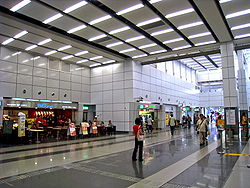

In 1975, the KCR asked two consultancies, Sofrerail and Transmark, to make proposals on the modernisation of the line. In 1979, Transmark's proposal to double-track and electrify the entire line for $2.5 billion (in 1979 prices) was accepted by the government. This work involved building a new tunnel through Beacon Hill as the existing tunnel was not wide enough to accommodate two tracks. New stations were added, including Kowloon Tong station, which was completed in 1982 to provide an interchange with the new MTR network. Tai Po Kau station and the original Tai Po Market station were closed, with the latter being redeveloped into the Hong Kong Railway Museum. The development finished in sections between 1982 and 1983, with new Metro Cammell EMUs, manufactured by Metro-Cammell in England, replacing diesel locomotives.
With the modernisation of the railway and the concurrent urbanisation of the New Territories, ridership rose quickly, from a daily average of 190,000 in 1983 to 491,000 in 1990. A temporary station in Tai Wai opened in 1983 while the permanent Tai Wai station was completed in 1986. Fo Tan station opened in 1985 to serve the expanding industrial estate. Tai Wo station opened in 1989 to serve Tai Wo Estate.
Expansion since the 1990s
The 1990s saw more rapid development and changes within the railway. The Kowloon-Canton Railway Corporation (KCRC) signed a contract with Anglo-French manufacturing giant GEC-Alsthom to refurbish the Metro-Cammell EMUs at the East Rail depot at Ho Tung Lau. In 1996, the first refurbished train was put into service on the line, which was now known as KCR East Rail (九廣東鐵), and trains now allow passengers to traverse from one end to another (except for the first class carriage), when trains once ran on four three-car EMUs. All but three of the 351 railcars were refurbished; the only unit exempt from refurbishment was unit E44 (144-244-444), which is currently stored in Ho Tung Lau depot. The yellow-cab train was formally retired with a "Farewell Ride" on 31 October 1999.
When refurbished, each set was still made up of 12 cars (with one first-class car). Prior to the rule proclaimed in 1994 which fixed the number of cars on each set to 12, trains were inconsistent in terms of length, ranging from six cars (two EMUs), nine cars (three EMUs) to 12 cars (four EMUs).
In terms of appearance, trains no longer have the monotonous design of having a red stripe running across the middle from the cab to the end; the doors now have a red coating, and the window panes along with the upper part are fashioned with blue paint. The original design of the train front, encapsulating the driver's cab and commonly referred to as the "Yellow-cab", was replaced with a more modern design capped with a silver coating, and a digital display added providing the train's destination.
The design of the EMU was modified as well: four more sets of doors being added to each car, adding up to a total of ten sets of doors, each side with five; the introduction of new passenger information plasma display; and more standing space by rearranging seating patterns from the traditional back-to-back seating to a longitudinal design.
In 1998, a new signalling system, known as Transmission balise-locomotive (TBL, as used in Belgium), came into operation on the line. This Automatic Train Protection (ATP) system, a replacement for the previous Automatic Warning System (AWS) developed in Britain, ensures a safe distance is maintained between trains. It also allowed an increase in train frequencies from 20 to 24 per hour each way. The control centre was also relocated from Kowloon station to a new facility in the KCRC operations headquarters building at KCRC House (now known as the Fo Tan Railway House). Also as part of the ATP project, a two kilometre section of the tracks near the Pak Shek Kok reclamation, curving around the former coastline, was straightened out during the mid-1990s. The tracks now run alongside the Tolo Highway. A vestige of the former alignment, an old bridge beside Cheung Shue Tan village built between 1906 and 1909, was identified by the Antiquities and Monuments Office in 2008 as a historic asset.
In 2002, an automatic train operation (ATO) system was added to TBL, which controls the speed of the train for the driver and ensures that all trains will stop when arriving at every station. Under normal circumstances, most trains are operated in ATO mode except for scenarios such as operation of trains in and out of train depots, driver training, or at times when the ATO system fails to function properly. However, intercity trains using the East Rail line continue to operate on AWS.
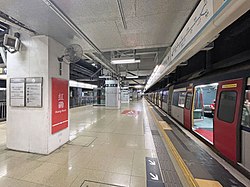
In 2004, the railway was extended in tunnel to a new southern terminus at East Tsim Sha Tsui station. On 28 December 2004, a branch to the East Rail, the Ma On Shan Rail was added, with an interchange at Tai Wai.
On 15 August 2007, an extension from Sheung Shui station northwest through a tunnel to Lok Ma Chau station was opened. This provides a second border crossing between Hong Kong SAR and Mainland China.
Development under MTR Corporation
The Kowloon–Canton Railway (KCR) network, of which East Rail was part of, was amalgamated into the MTR system on 2 December 2007. The KCR East Rail was renamed the East Rail line. At that time, the line terminated at East Tsim Sha Tsui in the south, and Lo Wu / Lok Ma Chau in the north.
On 16 August 2009, Hung Hom became the southern endpoint of both the East Rail line and West Rail Line after the completion of the Kowloon Southern Link. The section of East Rail line between Hung Hom and East Tsim Sha Tsui was taken over by the West Rail line, with the latter station becoming an intermediate stop on West Rail line (now part of Tuen Ma line).
As the COVID-19 pandemic started to affect Hong Kong in early 2020, the Hong Kong government closed all border crossings on the land boundary with Mainland China, including the Lo Wu and Lok Ma Chau Spur Line control points, on 3 February. During the closure, Lo Wu station served only certified residents nearby, while passenger service at Lok Ma Chau was completely suspended. Northbound trains terminated at Sheung Shui for three years, until Lok Ma Chau crossing was reopened on January 8, 2023 following the lifting of travel restrictions. Lo Wu station reopened to cross-boundary passengers on February 6, 2023, after completion of renovation.
Shatin to Central Link project

First conceived in 1967, the Shatin to Central Link (SCL) expansion project received approval in 2012, and began construction later in the same year. Phase 2 of the link is a southern extension of East Rail line which takes the line southward across Victoria Harbour to a new terminus, Admiralty station, on Hong Kong Island. The extension also includes an intermediate station at Exhibition.
In preparation for this extension, the TBL and ATO signalling systems in use on the East Rail line were replaced by the Trainguard MT communications-based train control system supplied by Siemens. The line also received new rolling stock in the form of 43 nine-car R-Trains, which would completely replace all existing trains used on the line. The new signalling system was slated to replace the old ones on 12 September 2020 and R-Trains would start carrying passengers on the same day, but one day before the changeover, the discovery of abnormalities that misrouted Lok Ma Chau bound trains into tracks towards Lo Wu on three occasions during the system reliability tests was revealed by a media report. The changeover of signalling systems was eventually postponed to 6 February 2021. From that day until 6 May 2022, East Rail line entered the stage of "Mixed Fleet Operation" (MFO) in which new 9-car trains were put to service, running alongside and gradually replacing the legacy 12-car Metro-Cammell EMUs (the SP1900 EMUs were removed from service on the line once MFO started).
Passenger services started on the cross-harbour extension on 15 May 2022. The extension allows New Territories East residents to reach the central business district in one train ride. During the first two weeks after the extension's commissioning, the patronage of the line's critical link, that is the section from Tai Wai to Kowloon Tong, during the busiest hour in the morning peak recorded a 27% increase from 26,000 to 33,100 pphpd. As the need to transfer from the line to other MTR lines (at Kowloon Tong or Hung Hom / East Tsim Sha Tsui) or cross-harbour tunnel buses (at Hung Hom) for destinations on Hong Kong Island is now eliminated, the new extension had relieved the critical links on Tsuen Wan line and Kwun Tong line of around 20% and 10% loading during morning peak, respectively.
The introduction of new trains and signalling systems under the SCL project presented an opportunity to improve the line's infrastructure. The local community had long fought for the retrofitting of automatic platform gates (APGs) on East Rail line platforms, yet the pre-SCL signalling system could not support their addition. As construction of the SCL project progressed, advance works for APGs installation including platform structure reinforcement was also carried out. A year after the cross-harbour extension opened, the installation of APGs formally commenced, with the first pairs of APGs at Racecourse and Tai Po Market stations putting into operation on 7 May and 3 June 2023, respectively.
Tunnels
Tunnels on the East Rail line have numbers assigned to them. When the railway was first opened, there were five tunnels:
- North of today's Mong Kok East station
- Beacon Hill Tunnel
- South of where University station stands today
- North of university station
- At Tai Po Kau
During the construction of the Cross-Harbour Tunnel, which opened in 1972, the section of tracks near Oi Man Estate, Ho Man Tin was covered to construct the section of Princess Margaret Road connecting to the Cross-Harbour Tunnel. A new tunnel was therefore created and given the number 1A.
During the modernisation of the line in the early 1980s, Tunnels 1, 3, 4 were removed by demolishing the mounds above them. Tunnel 1A already had double track width when built; a completely new Beacon Hill Tunnel (Tunnel 2) was constructed and took over the original one; and Tunnel 5 was doubled. The new one is known as Tunnel 5A.
Rolling stock
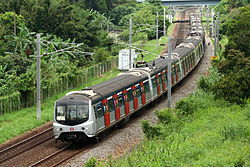
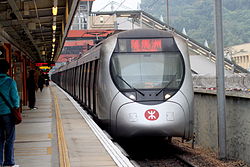

The line is currently served solely by nine-car R-Stock trains built by Hyundai Rotem, which entered service on 6 February 2021. Thirty-seven sets were built by Hyundai Rotem between 2014 and 2022.
Before the introduction of the new R-Stock trains, the East Rail line was operated with two types of commuter trains: the 29 refurbished Metro-Cammell EMUs (also known as Mid-Life Refurbished Trains) and eight sets of the newer SP1900 EMUs, manufactured by Kinki Sharyo of Japan in 2001. Both models shared the same exterior colour scheme, door arrangement (five pairs per car, except first class), as well as consisting of 12 carriages per train including a first class section. The interior design between the two models is different, and the transverse seating near the ends of the Metro-Cammell carriages has been replaced with longitudinal seating in the Kinki Sharyo models to allow for a wider gangway between compartments. All of the East Rail line Hyundai-Rotem trains are maintained at Ho Tung Lau Depot in Sha Tin.
With the construction of the Sha Tin to Central Link, which cannot accommodate trains of greater than nine cars, the MTR decided in December 2012 to phase out all of the aging Metro-Cammell trains from 2020 and replace them with 37 sets of 9-car R-Stock trains built by Hyundai Rotem of South Korea. In 2020, the MTR purchased an additional 6 trains bringing the total number to 43 sets. The first new train arrived in Hong Kong in September 2015 and entered service in February 2021. They fully replaced the older fleet in time for the opening of the Hung Hom to Admiralty section of the Sha Tin to Central Link on May 15, 2022. Due to the shorter train length, there are concerns that the new formation may worsen the existing overcrowding problem. However, the Transport and Housing Bureau and MTRC suggest that the new signaling system and higher train speeds will increase the train frequency from three minutes down to two minutes. It is also estimated that with the completion of the Sha Tin to Central Link (Tai Wai – Hung Hom section), 20% of the current East Rail line passengers will take the new East West Corridor.
The SP1900 EMUs were withdrawn from the East Rail line on 6 February 2021 and, together with the SP1900/1950 sets on the West Rail and Ma On Shan lines, are being reconfigured as 8-car trains to serve the Tuen Ma line. The conversion project is taking place at MTR's Pat Heung Depot and converted sets are being placed into service on the Tuen Ma line alongside newly delivered CRRC Changchun TML C-trains (nicknamed as the Fake SP1900 due to its similarity to the SP1900). The SP1900 first class cars will be shipped back to Kinki Sharyo factory in Osaka, Japan for conversion into standard-class compartments. The Metro-Cammell EMUs were retired on 6 May 2022, with the last train leaving Hung Hom at 13:00, departing for Sha Tin, and ending service there to a large crowd who took the train, with the crowd giving a big thank-you for the train, as it served Hong Kong for 40 years.
| MTR East Rail line Rolling stock | ||||
|---|---|---|---|---|
| Model | Time of manufacturing | Sets | Formation | Notes |
| R-Train | 2014-2022 | 43 | D-P-M+M-P-F+M-P-D | Manufactured by Hyundai Rotem |
| MTR East Rail line Former rolling stock | ||||
| Model | Time in operation | Sets | Formation | Notes |
| MLR | 06/05/1982–06/05/2022 | 29 | 1-2-5+6-2-5+6-2-4+6-2-3 1-2-5-5-2-6+6-2-4+6-2-3 |
Manufactured by Metro-Cammell; All 29 train sets have been retired and decommissioned from service |
| IKK Train | 04/09/2001–05/02/2021 | 8 | D-P-M-H+C-H+M-P+F-M-P-D | Manufactured by Kinki Sharyo; transferred to Tuen Ma line |
First class

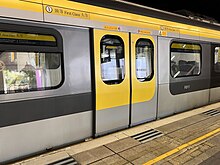
The East Rail line is the only railway in Hong Kong to offer first class commuter service. One car of each train is designated as a first class carriage (Northbound Car No.4 and Southbound Car No.6). These compartments have softer and wider seat arrangements; however, standing in the first class car is common during rush hour.
Riding on this carriage costs twice that of a standard-class journey and passengers are required to buy the first class ticket (at the vending machine on East Rail line stations or ticket counters at the other stations) or revalidate their Octopus cards on the first class reader (located at the station platforms and beside the gangway door of the First class compartment itself) before entering the first-class car. Ticket Inspectors will perform random checks on train, and failing to produce a valid first class ticket or validated Octopus Card will be liable to a surcharge of $1000.
Train service

Domestic trains on the East Rail line operate from around 05:30 to 01:00 the next day, running at around 3–8 minute intervals for most part of the day. Trains operate at roughly 15–16 trains per hour (tph) per direction off-peak, and drops to a minimum of 6 tph during early morning and late night hours. Most trains serve between Admiralty and Lo Wu or Lok Ma Chau, with one train to Lok Ma Chau following two trains to Lo Wu. However, Lo Wu and Lok Ma Chau stations close at approximately 00:30 the next day and 23:00 respectively, which means that Sheung Shui is the northern terminus after both border checkpoints are closed.
During peak hours, trains are more frequent, running every 2–3 minutes. Between Sheung Shui and Admiralty, there are 20 tph during morning peak, bringing the train frequency up to 2.7-3.8 minute intervals. Additional short-haul trains would also depart from Tai Po Market and Sha Tin, augmenting the number of trains south of Sha Tin to 23 tph.
The line's usual service patterns on non-race days could be summarised as follows:-
- Lo Wu – Admiralty
- Lok Ma Chau – Admiralty
- Sheung Shui – Admiralty (trains terminates at Sheung Shui after closure of boundary crossings; additional trips are also operated during morning peak)
- Tai Po Market – Admiralty (around 5 pairs during weekday morning peak; 2 southbound trips in the afternoon)
- Sha Tin – Admiralty (operated by trains leaving/returning to Ho Tung Lau Depot; early morning trips before first southbound train from Sheung Shui arrive at Sha Tin; 1 pair during morning peak; northbound trips also run in the evening)
- Sheung Shui – Hung Hom (northbound trips in early morning before first Lo Wu bound train from Admiralty arrives; also last few southbound trips at late night)
- Tai Po Market – Lok Ma Chau (first northbound trip in early morning)
- Sha Tin – Lok Ma Chau (northbound trips in early morning before first Lok Ma Chau bound train from Admiralty arrives)
Racecourse station is only open to passenger traffic during horse racing meetings at the Sha Tin Racecourse, during which some trains would be channelled through Racecourse instead of calling at the parallel Fo Tan station. Trains terminating at Racecourse might also be operated.
Cross-boundary train services
Train services to boundary crossings
Both Lo Wu and Lok Ma Chau stations are integrated with immigration control points between Hong Kong and Mainland China. The two stations are located within the Frontier Closed Area (FCA) and access is restricted to genuine boundary-crossing passengers with a valid travel document, and nearby residents holding Closed Area Permits.
Journeys to and from the cross-boundary stations (except approved FCA residents holding a Railcard) are charged at a premium, the proceeds of which is used to cross-subsidise fares of domestic journeys to a certain extent.
Intercity Through Train

Prior to the COVID-19 pandemic, the Intercity Through Train (Chinese: 城際直通車) service shared tracks with East Rail line domestic service between Hung Hom and Lo Wu. These intercity trains ran across the Hong Kong–China border and proceed to Guangzhou, Shanghai and Beijing in Mainland China. Intercity trains did not call at stations in Hong Kong apart from the Hung Hom terminus, where both inbound and outbound passengers complete their Hong Kong immigration and customs clearance.
On 30 January 2020, the Intercity Through Train service was suspended indefinitely amidst the pandemic. As the demand for long-distance train service has been catered to by the new Guangshengang XRL which opened 2018, there are currently no plans to resume the Intercity Through Train service despite the reopening of the border in 2023.
Stations
This is a list of the stations on the East Rail line.
| Colour scheme and Station Name | Connections | Opening date | District | ||
|---|---|---|---|---|---|
| English | Chinese | ||||
| East Rail Line (EAL) | |||||
| Admiralty | 金鐘 | 15 May 2022 | Central and Western | ||
| Exhibition Centre | 會展 |
|
Wan Chai | ||
|
Hung Hom formerly Kowloon |
紅磡 | 30 November 1975 relocated on 15 May 2022 |
Yau Tsim Mong | ||
|
Mong Kok East formerly Yaumati; Mong Kok |
旺角東 | — | 1 October 1910 relocated on 4 May 1982 |
||
| Kowloon Tong | 九龍塘 | 4 May 1982 |
Sham Shui Po / Kowloon City |
||
| Tai Wai | 大圍 | 15 August 1983 relocated 23 April 1986 |
Sha Tin | ||
| Sha Tin | 沙田 | — | 1 October 1910 | ||
| Fo Tan | 火炭 | 15 February 1985 | |||
| Racecourse | 馬場 | 7 October 1978 | |||
|
University formerly Ma Liu Shui |
大學 | 24 September 1956 | |||
| Tai Po Market | 大埔墟 | 7 April 1983 | Tai Po | ||
| Tai Wo | 太和 | 9 May 1989 | |||
| Fanling | 粉嶺 | 1 October 1910 | North | ||
| Sheung Shui | 上水 | 16 May 1930 | |||
| Lo Wu | 羅湖 |
|
14 October 1949 | ||
| Lok Ma Chau Spur line | |||||
| Kwu Tung | 古洞 |
|
2027 (expected) | North | |
| Lok Ma Chau | 落馬洲 |
|
15 August 2007 | Yuen Long | |
